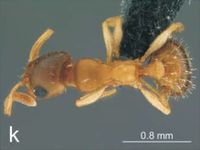Nesomyrmex inye
| Nesomyrmex inye | |
|---|---|

| |
| Scientific classification | |
| Kingdom: | Animalia |
| Phylum: | Arthropoda |
| Class: | Insecta |
| Order: | Hymenoptera |
| Family: | Formicidae |
| Subfamily: | Myrmicinae |
| Tribe: | Crematogastrini |
| Genus: | Nesomyrmex |
| Species group: | simoni |
| Species: | N. inye |
| Binomial name | |
| Nesomyrmex inye Mbanyana & Robertson, 2008 | |
One specimen collected in soil, while digging up another ant nest. Vegetation classified as Succulent Karoo: Western Little Karoo (Mucina & Rutherford 2006).
Identification
Mbanyana and Robertson (2008) - A member of the simoni species-group. Nesomyrmex inye is distinguished from the similar-looking Nesomyrmex njengelanga by the long curved hairs that are present on the ventral surface of head (versus straight hairs in N. njengelanga); promesonotal dorsum with reticulate ground sculpture overlaid by longitudinal rugulae (longitudinal rugulae reduced to a few near the inner margin of eyes in N. inye); eyes are larger (EI 42 versus 35–40); and the colour which is medium brown (versus yellow).
Keys including this Species
Distribution
Latitudinal Distribution Pattern
Latitudinal Range: -33.59805556° to -33.59816°.
| North Temperate |
North Subtropical |
Tropical | South Subtropical |
South Temperate |
- Source: AntMaps
Distribution based on Regional Taxon Lists
Afrotropical Region: South Africa (type locality).
Distribution based on AntMaps
Distribution based on AntWeb specimens
Check data from AntWeb
Countries Occupied
| Number of countries occupied by this species based on AntWiki Regional Taxon Lists. In general, fewer countries occupied indicates a narrower range, while more countries indicates a more widespread species. |

|
Estimated Abundance
| Relative abundance based on number of AntMaps records per species (this species within the purple bar). Fewer records (to the left) indicates a less abundant/encountered species while more records (to the right) indicates more abundant/encountered species. |

|
Biology
Castes
Nomenclature
The following information is derived from Barry Bolton's Online Catalogue of the Ants of the World.
- inye. Nesomyrmex inye Mbanyana & Robertson, 2008: 46, figs. 4j-l (w.) SOUTH AFRICA.
Unless otherwise noted the text for the remainder of this section is reported from the publication that includes the original description.
Description
Worker
Holotype. HL 0.713, HW 0.559, HW1 0.602, CI 78, SL 0.462, SI 83, PW 0.403, ML 0.816, EL 0.236, EI 42.
Mandibles with fine longitudinal striations. Clypeus with longitudinal striations anteriorly, smooth posteriorly with superficial fine reticulate patterning. Anterior clypeal margin convex but slightly pointed medially. Scapes of moderate length (SI 83). Eyes with 12 ommatidia in a longest row. With head in full face view, hind margin shallowly convex. Promesonotum evenly convex in profile. Metanotal groove conspicuously impressed. Dorsum of propodeum shallowly convex in profile; sides of declivity marginate and junction between dorsum and declivity angulate. Metapleural lobes low and rounded. Peduncle with a prominent keel-shaped subpetiolar process. Petiolar node rounded in profile with dorsum poorly defined; junction between anterior face and dorsum more narrowly rounded than between posterior face and dorsum. Post-petiole low and rounded. Head with fine reticulate pattern overlaid by fine longitudinal striations; striations more prominent in the vicinity near the inner margin of the eyes. Promesonotal dorsum with reticulate sculpture aligned in places to form fine longitudinal striations. Metanotal groove with cross-ribs. Posterior portion of the propodeal dorsum and declivity with transverse striations; anterior of dorsum with rugoreticulum. Both nodes with a superficial reticulate pattern. First gastral tergite with a ring of short basal costulae at the base and the remaining part smooth with a faint superficial reticular pattern. Dorsum of head with eight pairs of erect hairs, with underlying sparse pubescence. The venter of head with seven elongate curved hairs. Ventral margin of mandibles with short curved hairs and with one long curved hair at the base. Promesonotal dorsum with six pairs of fine erect hairs. Propodeum with two pairs of fine erect hairs. Petiolar node with four pairs of suberect hairs, postpetiole with five pairs of fine suberect hairs. Gastral tergite and sternite with regularly spaced suberect hairs. Colour uniformly medium brown.
Type Material
Holotype: South Africa: Western Cape: Ladismith, Rietfontein Farm adjacent to Touwsberg Private Nature Reserve, 33°35’53”S 20°59’57”E, 14 April 2008, N. Mbanyana & H.G. Robertson, SAM-HYM-C019803.
Etymology
In isi-Xhosa, inye means ‘one’ and this species is so named because there was only one specimen collected.
References
- Hita Garcia, F., Mbanyana, N., Audisco, T.L. & Alpert, G.D. 2017. Taxonomy of the ant genus Nesomyrmex Wheeler (Formicidae, Myrmicinae) in the Afrotropical region, with a review of current species groups and description of a new species of the N. angulatus group from Mozambique. European Journal of Taxonomy 258: 1–31 (DOI:10.5852/ejt.2017.258).
- Mbanyana, N. and H.G. Robertson. 2008. Review of the ant genus Nesomyrmex in southern Africa. African Natural History. 4:35-55.
References based on Global Ant Biodiversity Informatics
- Hita Garcia F., Mbanyana N., Audisio T. L., and G. D. Alpert. 2017. Taxonomy of the ant genus Nesomyrmex Wheeler (Formicidae, Myrmicinae) in the Afrotropical region, with a review of current species groups and description of a new species of the N. angulatus group from Mozambique. European Journal of Taxonomy 258: 1–31.

